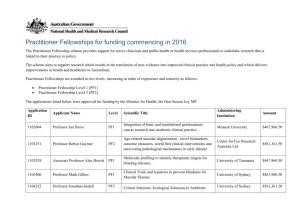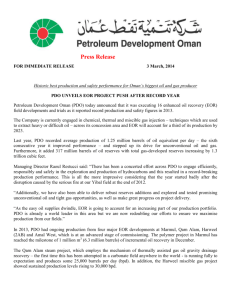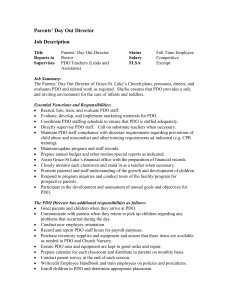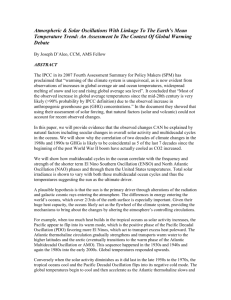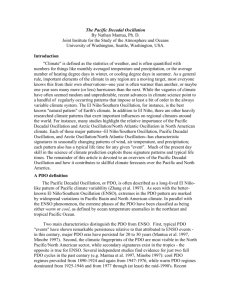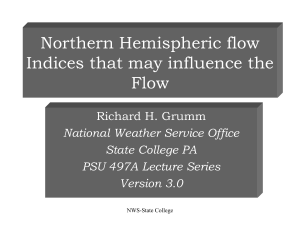Climate forcing of moisture variability - U
advertisement
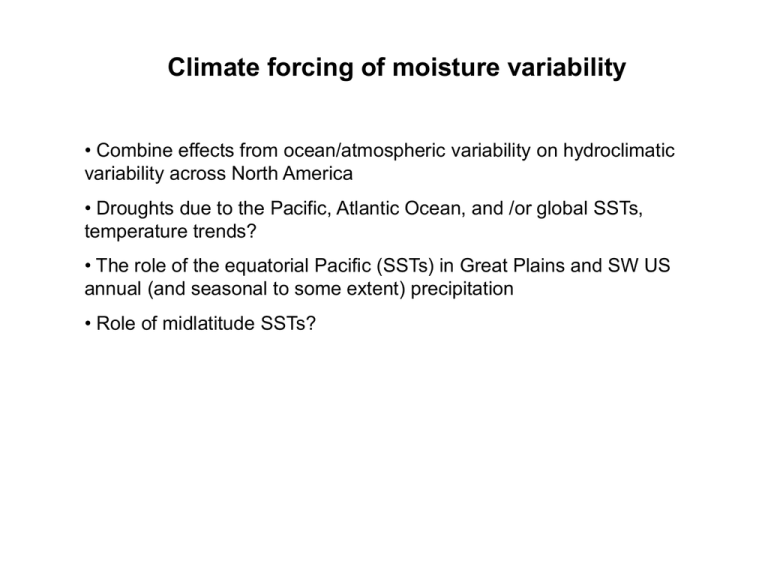
Climate forcing of moisture variability • Combine effects from ocean/atmospheric variability on hydroclimatic variability across North America • Droughts due to the Pacific, Atlantic Ocean, and /or global SSTs, temperature trends? • The role of the equatorial Pacific (SSTs) in Great Plains and SW US annual (and seasonal to some extent) precipitation • Role of midlatitude SSTs? Pacific Decadal Oscillation • A long-lived El Niño-like pattern of Pacific climate variability. • Similar climatic pattern, but different behavior in time (greater persistence) • The climatic pattern is most notable in the North Pacific/North American sector, with a weaker center in the tropics (opposite for ENSO). http://jisao.washington.edu/pdo/ Typical wintertime Sea Surface Temperature (colors), Sea Level Pressure (contours) and surface windstress (arrows) anomaly patterns during warm and cool phases of PDO, ENSO Relationship between PDO and NH Winter Climate Characteristic warm-phase PDO October-March air temperature anomalies, in degrees C. This field is based on linear regressions between the gridded surface air temperature data and the SSTbased PDO index, 1900-1993. Contour interval is 0.2 C. Contour map of correlation coefficients between gridded North American DecemberFebruary (DJF) precipitation and the SST-based PDO index, based upon data for the period 1900-93. http://www.atmos.washington.edu/~mantua/REPORTS/PDO/PDO_cs.htm PDO: 1998-07avg = -0.0065 (N-M); 0.1846 (ann) 1988-07avg = 0.2225 (N-M); 0.1977 (ann) Atlantic Multidecadal Oscillation AMO index: the ten-year running mean of detrended Atlantic SST anomalies north of the equator. Correlation of the AMO index with gridded SSTA over the world ocean (all seasons). The thick contour is zero and thin contours denote the 95% signicance level. Correlation of the AMO index with climate division rainfall with the Mississippi basin highlighted by light gray fill. The larger highlighted circles indicate correlations above the 90% signicance level. The color bar applies to correlations in both panels. Enfield et al. 2001: In all but the summer season (JulyAugust-September) the patterns are different from Fig. 1c and have far fewer significant correlations. The summer season pattern is similar and has many significant correlations. We therefore believe that multidecadal variations in summer rainfall are mainly responsible for the observed relationship. *annual AMO has been positive since 1997 http://www.aoml.noaa.gov/phod/docs/enfield/enfield_etal2001.pdf Mid-latitude Fronts, and Jet Streams • The latitudinal temperature gradient across the Earth's surface, (and thus, the latitudinal pressure gradient), achieves a maximum in the midlatitudes. • This coincides with the polar front, the boundary between polar and tropical types of air. • The polar front jet stream, is a high speed corridor of air responsible for creating and moving large pressure systems through the midlatitudes. • Additionally, a subtropical jet stream forms at approximately 30 degrees due to convergence of air aloft at that latitude (higher up, lower wind speeds due to a lower pressure gradient). http://www.uwsp.edu/geo/faculty/ritter/geog101/textbook/circulation/upper_tropospheric_flow.html Jet Stream Cross Sections http://www.usatoday.com/weather/tg/wjstream/wjstream.htm - from M. Gleuck Polar Jet Stream, Circumpolar Vortex, and Rossby Waves • Over the poles, very cold, subsiding air creating high pressure at the surface. • The surface subsidence creates a large area of low pressure aloft called the circumpolar vortex. • At the equatorward boundary of the vortex lies the polar jet stream. • The polar vortex expands and contracts through the year as a result of the shifting of surface energy receipt. • The equatorward edge, along the jet stream, takes on wave-like forms called Rossby Waves (or planetary waves), with cold air invading into the middle latitudes and warm air pushing poleward, and a mixing of air masses. http://en.wikipedia.org/wiki/Rossby_wave Climate forcing of moisture variability McCabe, G. J., M. A. Palecki, and J. L. Betancourt. (2004). "Pacific and Atlantic Ocean influences on multidecadal drought frequency in the United States." Proceedings of the National Academy of Sciences 101(12): 41364141. PDF Seager, R., Y. Kushnir, C. Herweijer, N. Naik and J. Velez, 2005: Modeling of tropical forcing of persistent droughts and pluvials over western North America: 1856-2000. Journal of Climate, 18(19): 4065-4088. PDF McCabe et al. questions to consider: • While this study shows nicely how much of the multi-decadal variability in drought might be explained by PDO, AMO and secular trends in temperature, how much of the overall variability in drought is captured by the multi-decadal band? • What does it mean for water resources across the country that we seem to be entering a positive (warm) phase of the AMO, and potentially a cool phase of the PDO (especially in the SW)? • How relevant is McCabe's assessment of the PDO and AMO today? Are we still in a positive AMO trend and if so, are McCabe's assumptions about a prolonged drought viable? • More generally, what does it really mean to a water manager that there is a correlation between PDO, AMO and 20-year drought frequency? This seems like it could be very useful information in a general sense, but what does it mean on the timescales that these managers are doing their forecasting or allocating? • Although it is not addressed directly in this paper, it would also be interesting to talk about how the different phases of AMO and PDO interact with the shorter-term variability in drought forced by ENSO, and how they may be related to one another (if at all). • What about the seasonality in precipitation regimes; seasonal signal in AMO, PDO? More McCabe et al. questions: • Is the 100-year record used in this study long enough to robustly establish the relationships pointed out by the authors (e.g. we only really have a record that includes one and a half “cycles” of the AMO)? • Is a 20-year running mean a reasonable (or the best) way to remove the annual and interannual signal in drought variability? • Does the Monte-Carlo approach to determining the significance of the correlations between the running averages make sense? Is this a reasonable way to establish significance when the degrees of freedom are so low? • McCabe used a Monte Carlo approach involving shuffling of the raw climate data to smooth the data. How reliable is this type of approach and has it been used by any other study? Seager et al. questions: • Seager et al. found "a zonally and hemispherically symmetric component to the persistent droughts and pluvials". So when it is dry in the plains, it is also dry in the midlatitudes of each hemisphere, indicating a tropical origin. How does a mechanism for this work? • What constitutes zonal versus meridional circulation and flow in the paper? Basin Overviews Select a river basin of interest in western US (or North America). Investigate the climate of region (range and seasonality, variability, circulation influences), gage records available, use the longest to show hydrograph (variations on flow over the year) and variability (year to year), discuss source of water supply (e.g., summer/winter systems, snow vs rain), flow characteristics, critical activities and/or water supplies issues (endangered species, dams, hydro) in the basin. Develop a short (15 minutes) power point presentation, and write a short summary for the blog. Hydrologic data resources: Hydro-Climatic Data Network (HCDN): Streamflow Data Set, 1874 - 1988 By J.R. Slack, Alan M. Lumb, and Jurate Maciunas Landwehr USGS Water-Resources Investigations Report 93-4076 http://pubs.usgs.gov/wri/wri934076/1st_page.html USGS Surface-Water Data for the Nation: http://waterdata.usgs.gov/nwis/sw Climate data resources: Western Regional Climate Center, Historical Climate Information: http://www.wrcc.dri.edu/CLIMATEDATA.html PRISM (precipitation and temperature data in a continuous, digital grid of monthly and annual estimates): http://prism.oregonstate.edu/ WestMap: http://www.cefa.dri.edu/Westmap/ (climate by county, div)


